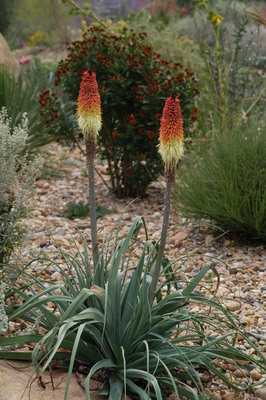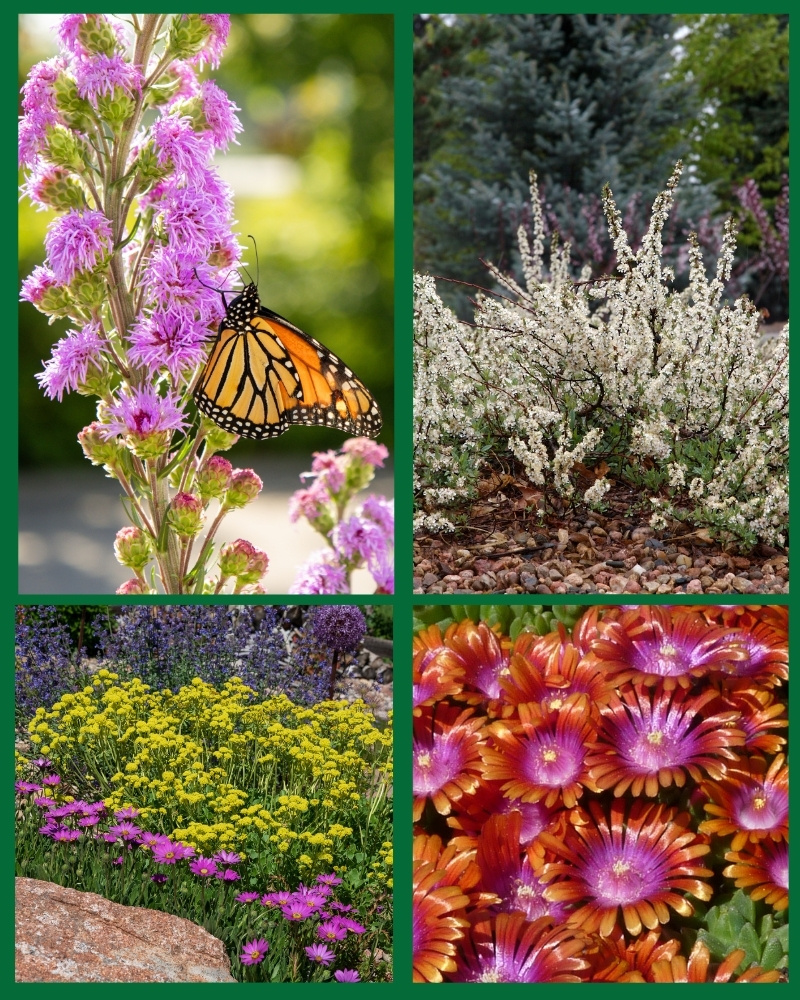Out of Africa – again! (regal torchlily)

Here’s another beautiful plant from South Africa to welcome to your Western America garden. The torchlilies also known as red hot pokers are familiar to many, but this particular species brings a unique twist to the typical color and texture of the foliage. The strap-like leaves are a rich blue-green and form a very structural rosette of foliage supporting sturdy, upright scepters of colorful torchlilies that flower in the later weeks of summer. These plants hold their own in exposed, sunny locations and will grow into large clumps that contrast nicely with finer textured plants such as Artemisias or with a stately backdrop of ornamental grass. The torches of flowers burn bright, their upright aspect lending an elegant and eye-catching form to the garden.
Regal Torchlily is easy to grow and prefers well-drained soil that has been lightly amended with compost. Native to the high slopes of the Drakensberg Mountains in South Africa it adapts comfortably to our regional conditions and looks quite at home in local gardens.
But make no mistake, this is not the typical red hot poker we’re accustomed to seeing in many gardens; the foliage is quite exceptional in color and form supporting impressive stalks of flowers. Visit Denver Botanic Gardens and Kendrick Lake Garden in Lakewood to see this plant in garden settings and then head off to your local garden center and introduce it to your garden. It will settle in beautifully among the other Plant Select® ice plants, gazanias, twinspur and sun daisies that have become happy transplants from South Africa in our regional gardens.
View the plant profile here.
Regal Torchlily (Kniphofia caulescens)
Perennial
Height: 40 inches
Width: 24-30 inches
Blooms: Late July to September
Sun: Full sun or part shade
Soil Moisture: Moderate to dry – Xeric with occasional deep watering during prolonged dry spells.
Hardiness: USDA zones 4b-9 (up to 7000’)
Culture: Clay, loam, or sandy soil. Thrives in traditional perennial borders, or in xeriscapes that get occasional deep watering.
Thanks to Harriett McMillan, Echter’s Greenhouse & Garden Center, for writing this piece.



I’ve had 6 Torch Lilies in my garden for 4-5 years. One of them bloomed small the second year. That’s it! They do spread but don’t bloom. They are in shaded in the afternoon by an evergreen tree & planted in soil with other perennials like Silver Sage & Red Birds and they are doing fine. I was thinking of getting rid of the lilies & putting in something else. Ideas?
Maybe move them to a sunnier spot? Another thing they like is deeper watering in spring. Maybe this year with all the moisture they’re getting they’ll do better. In the wild they grow in areas that are wetter in spring then dry out later in the season. Otherwise I think you’ve given them a good try – maybe it is time to try something else there.
I have several clumps of Kniphofia caulescens and it does well in the wet winters and dry summers of the Pacific Northwest with occasional deep watering in summer. Its foliage really is superior to most other Kniphofias’. Indeed, I would say that’s the main reason for growing K. caulescens, as its flower display lasts an extremely short time – barely a week – and then the “torches” become quite unsightly, even if, like me, you like dry stalks and seed heads that can stand through winter. K. caulescens also multiplies to form large clumps, then colonies, so either give it plenty of space, or be ready to remove offshoots after a few years.
I live at 7500 ft elevation just west of Durango, Colorado. In general, how much attention do I need to pay to elevation recommendations on the Plant Profiles? There are several plants I’m really interested in planting where it states 6200 ft is the maximum elevation. I really like the Regal Torchlily and the penstemons and hyssops are also capped at 6200 ft.
I have 120’ by 10’ area that I’m looking to plant with some ornamental grasses and with a pop of a couple bold colors.
The elevation guides are guidelines from gardens in Northern Colorado. Theoretically, as one plants in southern locations, all elevation guides could be increased. No firm answers, but try some plants out and let us know. Happy trialing!
Do you plant the new plants in the Fall? I just bought some
Yes you can. Do not over water these. Once per week until December should be ok if it does not get too hot.